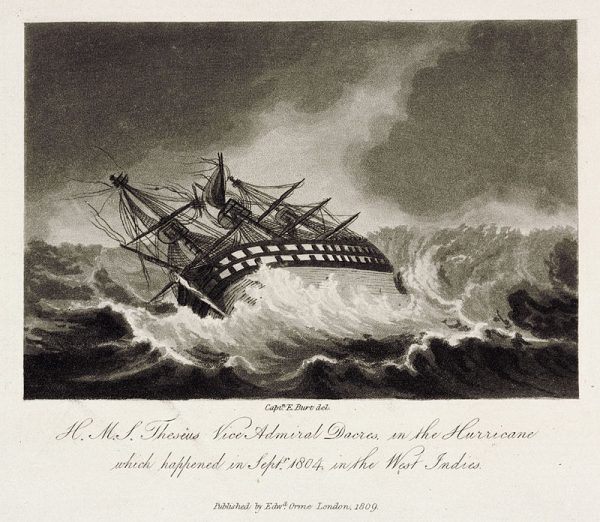He was on shore duty in the West Indies in April 1782 and thereby missed participation in the large fleet action, The Battle of the Saintes, off Dominica. This had culminated in a crushing British victory over the French.Go to the Dawlish Chronicles to read about the end of H.M.S. Hector.
In the course of this engagement, the French “74” line-of-battle ship Hector was captured. Though badly damaged in the action she was commissioned into the Royal Navy as HMS Hector. Under the command of Captain John Bourchier (approx. 1755–1819) she was ordered to return to Britain. Henry Inman joined her as First Lieutenant.
Getting the battered HMS Hector seaworthy for the Atlantic crossing involved removal of 22 of her guns and replacement of her masts with shorter ones, presumably so as not to over-strain her hull. Her crew was significantly short-handed, some 300 men, many of whom were invalids. In normal circumstances, a ship of this size would carry a crew of 500 to 700 men and it is therefore obvious that her fighting ability was very seriously impaired. She sailed in late August…
On the evening of September 5th HMS Hector was found by two 40-gun French frigates, L’Aigle and Gloire. These fresh, undamaged vessels quickly perceived HMS Hector’s decrepitude and one placed herself on her beam, and the other on her quarter and began to pour fire into her. Poorly manoeuvrable, HMS Hector was badly placed to avoid several rakings but she returned fire sufficiently to damage both attackers. It was a very creditable performance for a ship so weakly manned and armed. Even so, had the French vessels continued the bombardment from a distance they might have sunk HMS Hector. Instead they made the mistake of attempting to board and their efforts were bloodily repulsed. The action was broken off after six hours and both French ships bore off. . . .
Hector’s survival had been dearly bought. 46 of her crew had been killed or wounded, an especially serious concern when so many of her complement were already invalids. Captain Bourchier had been so badly wounded as to be incapacitated and effective command now passed to the twenty-year-old Henry Inman. The ship herself had been weakened yet further – the hull had sustained more injury, as had the masts, rigging and sails.
It was in this state that HMS Hector was to encounter the massive hurricane that swept through the Central Atlantic on September 17th. Battered by high seas, she lost her rudder and all her masts. Leaks were sprung and incoming water reached a level at which a major portion of the provisions and fresh water was spoiled. Survival now became a matter of continuous pumping, a labour that demanded physical exertion on an open wind and spray-lashed deck which would have been severe for a fit and healthy crew, but almost impossible for one so debilitated.
History, analysis, and unabashed gossip about the start of the American Revolution in New England.
▼
Saturday, August 12, 2023
Lt. Inman and the Hector
Antoine Vanner at the Dawlish Chronicles website just highlighted how Lt. Henry Inman (1762–1809) of the Royal Navy ended his Revolutionary War.

No comments:
Post a Comment